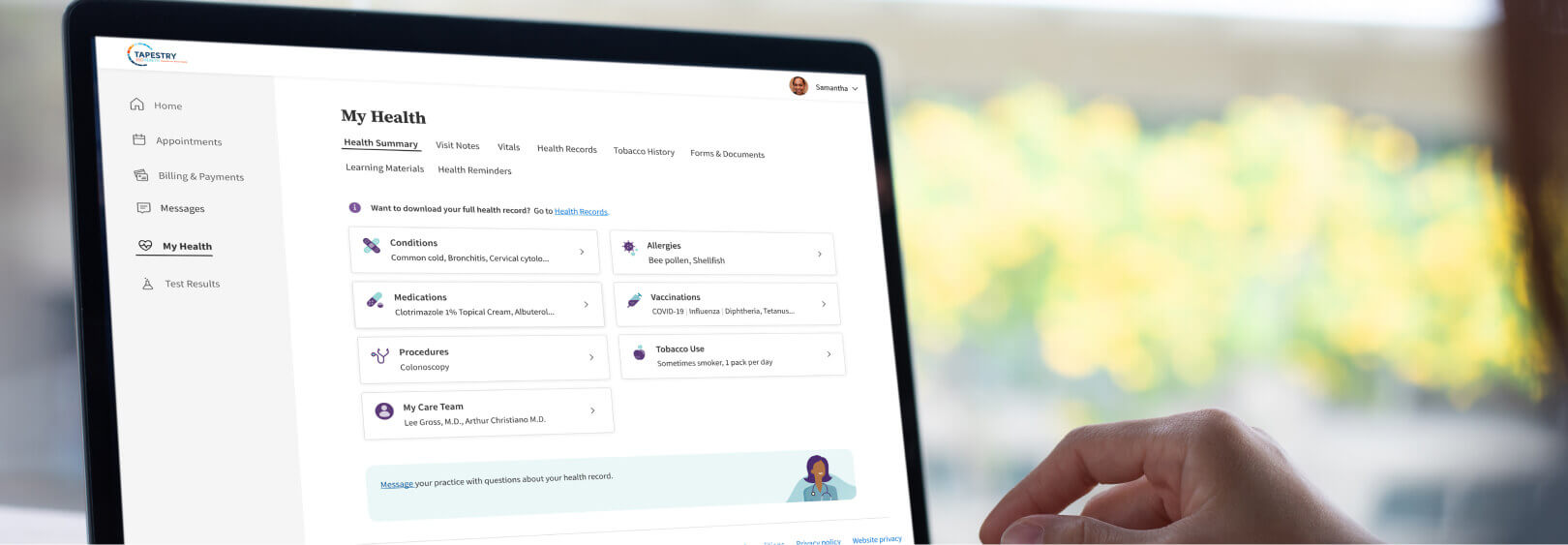How a Chicago FQHC drove patient portal adoption
When patients are empowered with the right digital tools, engagement improves, communication flows more easily, and medical practices run more efficiently. But that transformation doesn’t happen by accident. The digital patient engagement journey of Tapestry 360 Health, a Chicago, Illinois FQHC, offers a practical playbook for practices aiming to improve patient access, communication, and satisfaction through digital tools.
Tapestry 360 Health serves more than 28,000 patients across its 14 clinics on the north and northwest sides of Chicago. The FQHC’s experience implementing athenaOne®’s Patient Portal and building a campaign to encourage adoption offers insight into what works, what doesn’t, and what makes a lasting impact on patient communication and clinical workflows. Here are some of the key lessons and strategies that worked for Tapestry 360 Health, with practical takeaways for other practices looking to improve engagement.
1. Start small and scale with intention
It's not necessary to wait for conditions to be “perfect” before launching a patient digital engagement initiative. Tapestry 360 Health began their portal implementation with limited patient awareness, inconsistent system settings, and no formal staff training. Initial progress was slow, but by optimizing backend configuration issues and focusing on achievable near-term goals, the team created a solid foundation for adoption. What started as a handful of departments using the portal grew into a coordinated, organization-wide effort. Their advice for others: start with your most engaged teams, fix what’s broken, and grow from there.
2. Prioritize privacy for staff and patients
Early in their rollout, Tapestry 360 Health identified an opportunity to strengthen staff privacy by adjusting how names appeared in patient messages. They updated the privacy defaults and display settings to show job titles instead of full names, which helped reinforce professional boundaries and increased staff comfort. The change was simple but impactful. Tapestry 360 Health encourages other practices to proactively review and customize privacy settings to support both staff confidence and patient trust from the start.
3. Simplify access for families
Parental and proxy access to the patient engagement portal is important for practices to consider, especially for pediatric or elderly patients. And with six of its 14 clinics located at elementary and high schools, Tapestry 360 Health took extra care to ensure that its youngest patients weren’t accessing the portal unsupervised. For the school-based clinics, the FQHC configured its registration workflows to prevent children under 12 from receiving personal portal access and ensured the “Add Family Member” function was used consistently. This improved the portal registration process and clarified parental access. Their advice: build clear rules for access, train your front desk staff on those rules, and be ready to support common use cases for your patient population.
4. Offer support in patients’ preferred languages
As a Community Health Center, Tapestry 360 Health serves a diverse population. English is not the primary language for about one in four (23%) of their patients, so language accessibility emerged as a key enabler for encouraging portal use. athenaOne®’s Patient Portal is accessible in languages other than English – an important consideration for the FQHC. To reach as many patients as possible, the staff created portal instructions and how-to videos in both English and Spanish and has advocated for future support in Haitian Creole. This strategy directly improved engagement among Spanish-speaking patients. The takeaway: Prioritizing language support early helps reach underserved populations and improve health equity.
To promote portal use, include the portal in community-facing moments and make it part of the daily conversation, not just a backend tool.
5. Bring the portal into the community
Medical practices can and should leverage community events as opportunities to talk up the portal with their patients. To improve patient awareness and adoption, Tapestry 360 Health hosted a booth at their health fair, printed “Ask me about the portal” shirts for staff, and created posters and flyers for clinic locations. These visibility efforts made a measurable difference. To promote portal use, the team advises practices to include the portal in community-facing moments and to make it part of the daily conversation, not just a backend tool.
6. Make it a team effort across departments
Tapestry 360 Health’s success was built on cross-functional involvement. Medical assistants, front desk staff, clinicians, nurses, and even marketing and revenue teams each played their part — from attaching support documents to patient inquiries to personally helping patients navigate the portal. The shared ownership model proved essential. Their advice: define each team’s role in portal use and make engagement a shared goal across departments.
7. Use data to guide next steps
When monitoring patient engagement activity, it’s smart to look at the specific ways patients are using the digital tools available to them. Tapestry 360 Health used the Patient Digital Engagement Index, a metric available within the athenaOne Insights Dashboard, to monitor adoption rates, patient message activity, and department-level engagement. This data allowed them to target outreach efforts, identify areas for improvement, and share success stories. For other practices, the recommendation is clear: let data inform your feedback loop and it will tell you where to focus and what’s working.
8. Celebrate wins and keep improving
Keeping patient engagement top of mind across the practice is an important component of a campaign’s success. From staff shirts to interdepartmental competitions and patient feedback, Tapestry 360 Health built a culture of continuous improvement as they executed their year-long campaign to expand Patient Portal use. They embraced progress over perfection and kept moving forward with each new insight. Their advice: celebrate early portal adopters, highlight success stories, and keep portal engagement visible across the organization.
How athenahealth supports digital engagement at scale
Tapestry 360 Health partnered with athenahealth to help accelerate their digital engagement strategy. Using the athenaOne Patient Portal enabled them to create a consistent, accessible experience for a diverse patient population – and they’re planning to extend their reach by promoting adoption of the athenaPatient® mobile app. Their athenahealth Customer Success Manager lent hands-on guidance, helped them tailor configuration settings, and shared best practices to help ensure staff and patients received the support they needed at every step.
The Tapestry 360 Health team also leveraged the athenahealth Insights Dashboard, especially athenahealth’s Patient Digital Engagement Index, to track portal registration trends, message activity, and department-level adoption over time. This data allowed them to fine-tune outreach, identify barriers, and monitor progress across the organization. As a result, they were able to make meaningful improvements in digital engagement without overwhelming their frontline teams.
If you’re exploring new ways to improve connection and communication with your patients, athenahealth offers the patient engagement platform, the partnership, and the data-driven tools to help you succeed. It’s all part of athenaOne.
Planning your own patient engagement campaign?
Download our white paper, Patient Engagement in the Age of AI, to learn how next-generation digital patient engagement tools are shaping the future of care delivery and improving outcomes for practices and patients alike.











